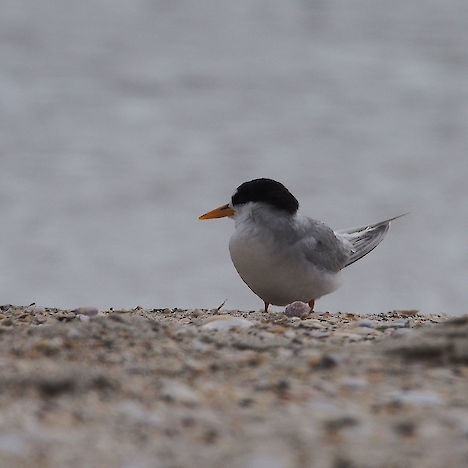Other names:
Tara itiThreat category:
Threatened: Nationally Critical?Regions:
Northland, AucklandDistribution:
Breed at four coastal Northland sites, disperse to harbours and estuaries in northern New Zealand
Identification
- Caspian terns are the largest terns in the world (51 cm long), are silver-grey and have a very large, red bill.
- White-fronted terns are the most common tern species on the New Zealand coast and are often seen in large flocks. They can be difficult to tell apart from other similar-looking terns. White-fronted terns are medium-sized (40 cm long), and have a black cap that does not join the black bill (the caps of other ‘black-capped’ tern species touch the bill).
- Fairy terns are very small terns (25 cm long) with a black crown, grey upper wings and body, white chest and head and a yellow bill. They are very similar in appearance to little terns (an uncommon Asian migrant).
Interesting Facts
- The New Zealand fairy tern numbers approximately 40 birds and less than 12 breeding pairs. It is New Zealand’s rarest breeding bird, and is at considerable risk of extinction due to a variety of threats including introduced predators and human disturbance.
- Fairy terns nest locally at four sites in Northland at Waipu, Mangawhai and Papakanui sandspits, and Pakiri River mouth (one pair since 2003). After breeding, the terns visit habours and estuaries between Auckland and Whangarei, but mostly Kaipara Harbour.
- Elsewhere, fairy terns breed in Australia and New Caledonia.
- The Caspian tern breeds throughout all continents except South America. It breeds around the New Zealand coast, and occasionally inland.
- Despite being widespread, the Caspian tern is a rare species, numbering approximately 1,300-1,400 breeding pairs, and is considered to be in decline primarily due to introduced predators and human disturbance.
- Caspian tern can breed singly but are often seen in small to large (c.100 pairs) colonies.
- Several major Caspian tern colonies have been disturbed by human activity and developments and marram infestation.
- White-fronted terns are only found in New Zealand. They breed on all coasts, but are most common on the eastern coasts.
- The white-fronted tern population is declining due to the impacts of human disturbance and introduced predators.
- White-fronted colony locations can change regularly. Colonies are generally on sandy beaches and sandspits, or shingle/shell banks and rocky islets.
Association with Plantations
- Coastal forests may have coastal birds on forest margins.
Threats
- Human disturbance including vehicle and foot damage to nests, people walking dogs, and general interference keeping birds off nests.
- Residential, pastoral and plantation developments.
- Predation by mammal pests and gulls, especially during nesting.
- Floods, high tides and storms are a major threat to fairy terns.
- Invasive plants like marram grass, lupins and wilding pines, can degrade nesting areas.
Management Options and Methods
- Minimise disturbance to nesting sites (cordon nests sites from people).
- Consider restricting or minimising vehicle access to important nesting sites.
- Consider removing invasive plants from dunes.
- Work with local community groups, DOC and councils to improve overall protection of important nesting colonies. This could include community education, plant and animal pest control, and roping off of nesting areas and appropriate signage.
- Injured or dead coastal birds (all species):
- Place injured birds in a cardboard box in the shade and deliver to a local vet, SPCA, or DOC.
- Call DOC if a bird is banded.
Monitoring Options
- Increase staff and contractor knowledge about coastal birds.
- Consider monitoring important nesting sites. This could include bird counts and chick survival rates.
Further Information and Support
- New Zealand Birds Online: New Zealand fairy tern, Caspian tern, white-fronted tern.
- Heather and Robertson (2000). The field guide to the birds of New Zealand.
- Pest management: DOC, Regional Councils.
- Department of Conservation website: New Zealand fairy tern.
- Local community initiatives: NZ Landcare Trust.


